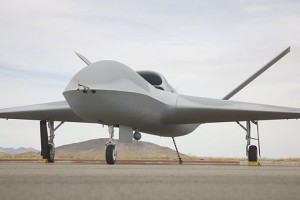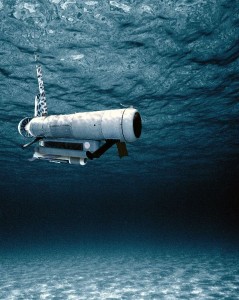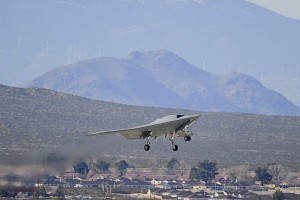 Even the most optimistic unmanned evangelists must acknowledge that naval doctrine will, eventually, boil itself down to a simple precept: “Kill the Robot, and Quickly”.
Even the most optimistic unmanned evangelists must acknowledge that naval doctrine will, eventually, boil itself down to a simple precept: “Kill the Robot, and Quickly”.
My sense is that America, as the first-mover in the unmanned space, finds that future somewhat distasteful. It is difficult to move from uncontested exploitation of potential utility to a suddenly crowded and increasingly contested niche. The transformation from limitless super-secret potential into a mundane and highly-contested reality is usually rough and full of miscalculations.
To preserve some measure of status quo, the U.S. (and a few others) are trying to grant people-less platforms some kind of legal standing and protection (“no, no, no….that crew-less Sea Hunter USV is NOT a wreck and you CAN NOT salvage it!”). But any faith that some fuzzy-ole’ internationally-recognized legal framework can guarantee the free passage of unmanned military or government-owned craft is misguided. Faith in the Rule of Law–at least at sea–should have expired long before China snatched a U.S. glider in 2016. Nobody should have been surprised that China grabbed an unmanned glider when it could; the U.S. and many other countries have done similar things. Interfering with rivals’ unattended infrastructure–be it a buoy, communication line , “ceremonial” underwater flags or even sea graves –is common. Any rival’s unmanned kit has-and always will be-exploitable.
But too few are talking about the prospects of adversaries “messing” with or “interfering” with unmanned craft. My sense of the future is that anything with targeting or other disruptive potential cannot–and will not–be allowed to collect or transmit unmolested. Far too many people give lip service to unmanned platforms. “Oh yes,” they say, waving their hands, “in wartime, all this ISR and unmanned stuff will be gone”, when in fact, in the future, maintaining ISR and unmanned stuff is gonna be a constant battle–an unrecognized and unpublicized one, but contested and fought-over nonetheless. And that is going to make the seas a whole lot meaner.
That’s scary. Now, with all due respect to the beady-eyed folks behind the mysterious locked green door, some operators of advanced systems understand the challenge ahead–they’re living this future today. They’re ready. But every-day leaders, policymakers snd the public have got to understand that unmanned platforms are at real risk of being killed off (or at worst, interfered with) at any time. They need to be ready for the prospect that the unmanned space could become really quite rough as countries jockey for position and security.
My concern is that, as the stakes increase, the barrier for aggressive “shoot first and ask questions later” action against unmanned craft is becoming very, very low. Some interference with disposable robot platforms can be absorbed. But at some unknown point, the fun and games end. One day the rubicon will be crossed– critical services provided by some pricy future robot platform will make the loss impossible for a country to bear without retaliating–only nobody–NOBODY–knows where that line is yet.
And that is a recipe for war.
We, as a society, are not ready. Nobody–from the U.S. on down–is prepared for a constant and undeclared war against pesky unmanned platforms. We’re talking about a very kinetic future as NORMAL. Drones and robots are going to be constantly battling it out for access on the fractious margins of various countries’ Areas of Control, and the levels of disruption and loss rates will be far higher than anybody can comprehend right now. That means that conventionally-crewed platforms will need to be on their toes, and ready to fight–if not be fighting–constantly when outside their AOR.
People are going to die over this.
 Dangerous Waters Ahead
Dangerous Waters Ahead
So how do we move ahead? To me, the only way to slow the global trend towards zero tolerance for unmanned craft is to complicate the targeting process, and essentially make it very, very difficult for observers/targeteers to distinguish between manned and unmanned craft. I mean, while the average PLA(N) commander will likely have a free hand in dispatching pesky drones, taking a life will still be relatively sacrosanct.
Ultimately, the harder it is to determine if people are aboard a potentially vexing sensor, the longer that platform is going to live.
So…in my mind, optionally-manned has got to become more of an accepted “thing”. And that, of course, will be innately risky. So we need to begin thinking really hard about how to accommodate some sacrificial E-3s standing a lonely watch on the autonomous Sea-Hunteresque craft of the future, or to protect some 0-3 riding impotently in a jump-seat of some hopeless-diamond-shaped and sensor-bedecked airborne lozenge.
A second route is to tether unmanned with manned–and so tightly integrate unmanned with the manned platform that, again, the robot is harder to target and exterminate. That also raises the risk for the poor SOB charged with deploying and tending some kind of fleet of flying rubber dog shit outside of, oh, Hong Kong, but, hey, it’s a job the robots won’t be able to easily claim as their own.
Another route to survival is standard and platform-based–to harden, obscure, minimize, miniaturize or otherwise protect the platform, which then, of course, just encourages harder, tougher responses in opposition.
The final route is to be virtually sacrificial, almost just asking for a hit.
 Conclusion
Conclusion
In the maritime, the robot world is going to be a rough-and-tumble place. And we, as a society, are unready for it. Safely negotiating–or tolerating- robot conflict is a global challenge.
This “kill the robot” future has huge implications. It’ll transform naval engineering and naval tactics. Overall readiness, weapons mixes, magazine sizes, EW capes, generators and a ton of other tiny things will need to change. Platform choices will shift. Risk calculations need fundamental re-tinkering. And mind-boggling levels of procurement are going to be coming once America sets upon a path forward.
But before we move down that road, America needs a strategy that is unencumbered by the distractions from the neat tactical confectionary unmanned platforms offer us today. And many more people need to know that much of this bright robotic potential may be seriously limited by active opposition.
And that isn’t happening. And that should concern everybody.

{ 12 comments… read them below or add one }
This does paint a rather dreary picture, but one the defense gurus need to weigh heavily. An unmanned sub-hunter of over 100 feet is going to be able to play in only certain spaces, and can’t count on any support. At what point does there need to be a logical cut-off that your unmanned vessel needs to be incredibly stealthy, and yet small enough and cost effective enough that you can shrug your shoulders and say “eh, we lost one”. Sea Hunter seems on the extreme end right now. Is it very quiet and can it go in spaces where we don’t want to leave a frigate or such hunting for a sub? It certainly can’t go in a contested area near an enemy coast or formation. At same point, there is crossing the line, putting in AI, and just have it loaded with sensors to detect attacks, and in essence return fire. If it can detect a sub whom attacks it, I’d take the trade of a Sea Hunter for a Chinese Kilo sub any day of the week, and it would certainly change enemy intentions. But the idea is to have a source multiplier for your military, and if they are all tethered to nearby fleet, or have size expanded to add a human body, well, it plays into our version of the rules, maybe not China’s, but we can use it for excuse cause effect if one is blown up with the poor E3 on board. Honestly, if they want to make a deadly force multiplier, they should look at some of the mock-up sea wolf and VA class they have in the Idaho lake, like the 90 foot mock-ups, and have them go silent, deep and just lay low, and oh, have ability to launch 2-4 torps. That is the way to make one understand you mess with it, it can kill you real bad. Just my two cents.
This topic is a solid follow-up to NextNavy’s prior piece about the unmanned and therefore “undeterable sub.” At issue is whether the public, defense, and naval community is sufficiently thinking ahead to a potential unmanned incident that prompts escalation. I would ask: are there already pressures (political, budgetary, lobbying) that may ‘set-up’ the USN for failure? (Unintentionally of course.)
I recall now-retired JCS Chairman Admiral Mike Mullen testifying that the biggest threat to the U.S. defense budget was, ironically, healthcare costs. While I’m sure Mullen just wanted cheaper medical costs, another option was implied: the faster we replace personnel with automation, the fewer troops will result in fewer medical procedures, facilities, medics and post-career veterans care. Of course automation has for decades reduced crew sizes. (Consider the first nuclear cruiser, USS Long Beach, had a crew four times larger than today’s cruisers and destroyers.) The pressure on personnel costs is always there to cut crew sizes, increase automation and thus create an over-reliance on drones.
Also consider congressional lobbying efforts by defense contractors offering unmanned systems. For legislators the appeal is two-fold. 1. Contractors make campaign donations while troops don’t. 2. Contractor manufacturing jobs bring more federal dollars to a given district or state than relocating a destroyer’s home port. So that’s another example of pressure in the direction of fewer crews and more robots.
The manned-vs-unmanned calculus must at some point resist these pressures to take automation too far. Otherwise, adversaries in peacetime will conclude – and they have – that 1.) a crewed U.S. vessel or aircraft demonstrates national resolve, therefore deterrence, and; 2.) replacing crewed platforms with unmanned and expendable drones may telegraph a shrinkage of national resolve and invite target practice without consequences.
Great comment TMark! Thanks!
Lots of good areas for future discussion here….
“the U.S. and many other countries have done similar things. Interfering with rivals’
unattended infrastructure–be it a buoy, communication line , “ceremonial” underwater
flags or even sea graves –is common. Any rival’s unmanned kit has-and always will be-
exploitable.”
Even a manned platform deploying a sensor array can be “pickpocketed”. Remember
Operation Barmaid?:
https://www.telegraph.co.uk/news/uknews/defence/9602103/HMS-Conquerors-biggest-secret-a-raid-on-Russia.html
Yep. Plenty of shenanigans to go around….Just worry that with un-crewed gear there is no need to be so subtle. Adversaries can just kill ’em.
The Chinese don’t even bother being subtle:
“The trawlers came within 25 feet of Impeccable, as part of an apparent coordinated effort to harass the unarmed ocean surveillance ship. A crew member on a Chinese trawler used a grapple hook to snag the towed acoustic array of Impeccable.”
Grabbing a SURTASS array must have been a nice intel coup for China.
See:
http://www.marinebuzz.com/2009/03/11/china-warns-usnavy-ocean-surveillance-ship-to-stay-away-from-hainan-island/
Well, I disagree. Hell, China shot down what, five (“Taiwan”) U-2s? The list of missing recon aircraft China has shot down over the years is pretty long (and, frankly Russia’s list is long too) and yet the U.S. didn’t respond to the shoot downs in any kinetic fashion (we can argue about who might be provoking whom here forever, but the gist is that the U.S. won’t do much if you push). I am pretty sure that informs Chinese behavior–though I’d be very interested to know if China has changed the way it responds to U.S. recon flights today. (I would say that as the US means to respond to such things in a non-kinetic fashion dwindle, and as we leave the UN and collaborative economic fora behind, the calculus may change in favor of lashing out militarily. I dunno)
But….it’s clear that nobody is going to tolerate things peeking at activities that are best kept unseen. And that means UAVs and USVs are going to get messed with or destroyed (less so USVs as they’re still hard to ID, hard to attribute nationality and difficult to determine if they’re manned or not.).
I don’t disagree and didn’t mean to imply that I did.
My examples fall on a spectrum of what the Navy could do. As you suggest, flying a UAV or sailing a USV far from any manned asset is just asking our adversaries to destroy them. It’s helping them win the Gray zone war. Our reaction would be limited to non-existent. Often we would suspect who destroyed them but not actually know.
Using a UAV/USV in close proximity to our warships can not only be a force multiplier but can give us a means of protecting the asset. Now I would not argue with your suggestion that the Navy may do nothing if China still attacked the UAV/USV.
But that is a whole different argument. If a country is willing to accept the loss of assets, manned or unmanned then as I said, it cries out for us to take our marbles and go home. We’ve abandoned the field anyway. Why pretend?
But make no mistake about it, China and to a lesser degree Russia will have to get a bloody nose to stop them taking over and remaking the world as we know it. The longer we wait the larger the bloody nose that is required.
Again these are just examples. There are numerous ways to give China and Russia the required bloody nose. We just don’t want to do it. That is the problem. So when thinking about U.S. unmanned assets there isn’t just the manned/unmanned paradigm but plain ordinary strategic differences involved.
Ah, ok got it. Good points!
What happens when the robots start shooting back? Remember that a U.S. Predator
drone fired at an attacking Iraqi Foxbat, and if the drone had been armed with a
longer-ranged missile than Stinger, then it might have succeeded:
http://aviationintel.com/predator-vs-foxbat-the-future-of-air-to-air-combat-via-drone-began-almost-a-decade-ago/
Great post.
I think the key is control/proximity balance and our reaction to it.
So the Navy talking about using the Triton as an EP-3 is a formula for having it shot down off the coast of China. We can respond but it suggests that slow walk into war.
But having the the same Triton giving a multiple view per day snap shot/persistent surveillance of the South China Sea where a Surface Action Group is located allows the U.S. to say, China shot at our SAG from it’s artificial islands and we retaliated by destroying runways and missile systems of the illegal Chinese bases in the Spratly’s.
Because China has committed acts of war we also destroyed it’s bases in all the SCS. We then can flood the SCS with carriers and submarines. We can demand China remove the bases or we will invade them.
The first is what I believe the USN will do. More acts of weakness. The second would solve a problem and would not lead to war with China. If the Navy is going to be weak, we should leave Asia and save the money.
If we want to partner with our allies then we will have to stop China. That stopping will require a physical act. No doubt about it the U.S. does not want to do that. We want to split the difference. As you suggest we will lose a lot of unmanned craft in the process.
The example of the Sea Hunter is a great one. Send it out alone and have it sunk by? A submarine. Who would have thunk it. I fear the U.S. is willing to play into the hands of our gray zone adversaries.
But using Sea Hunter on the outer ring of a SAG/ESG/CSG is a great force multiplier. Again, one is playing into the hands of our adversaries and the other is killing an enemy that attacked a U.S. Naval group. Big difference in outcome.